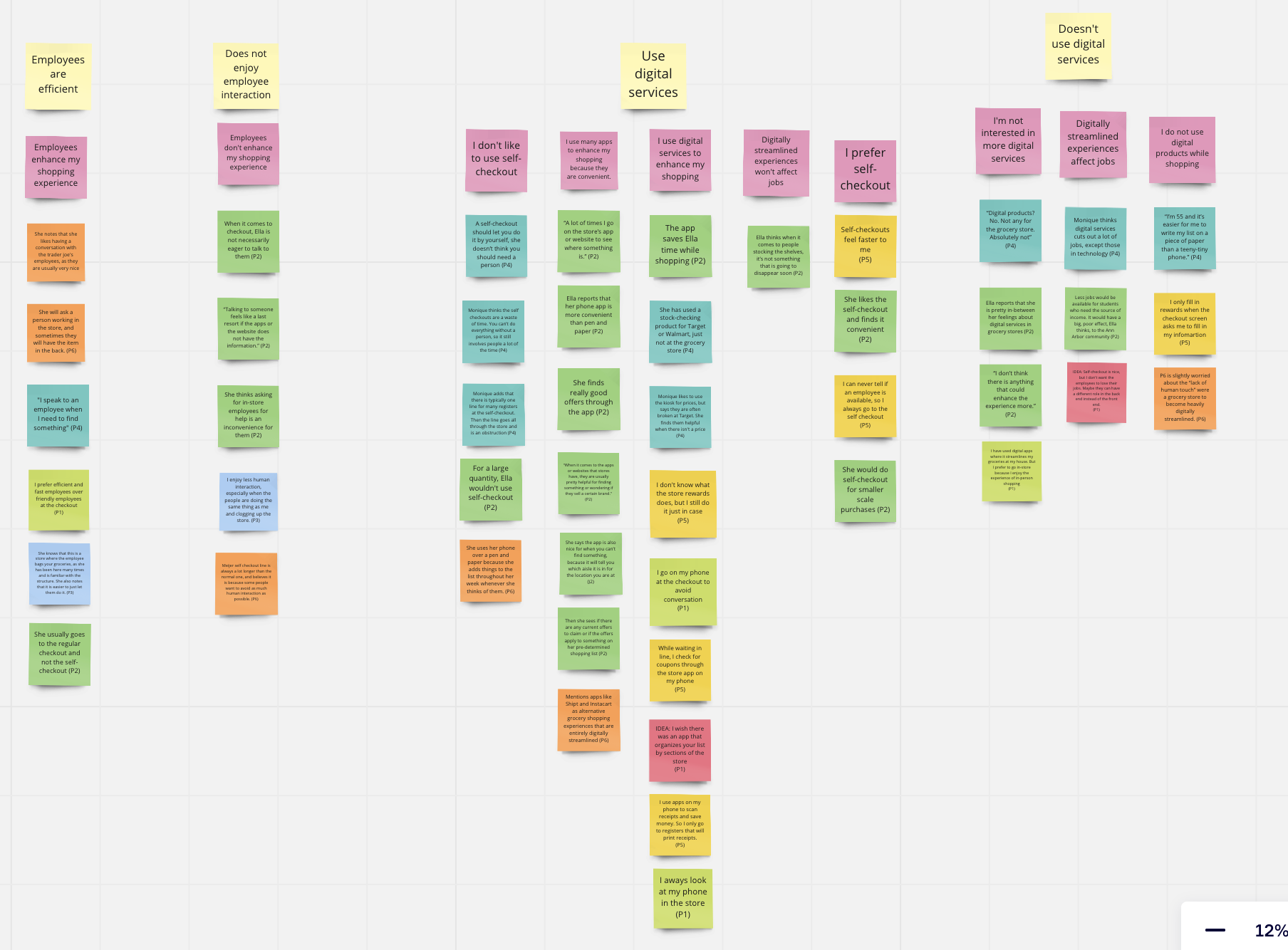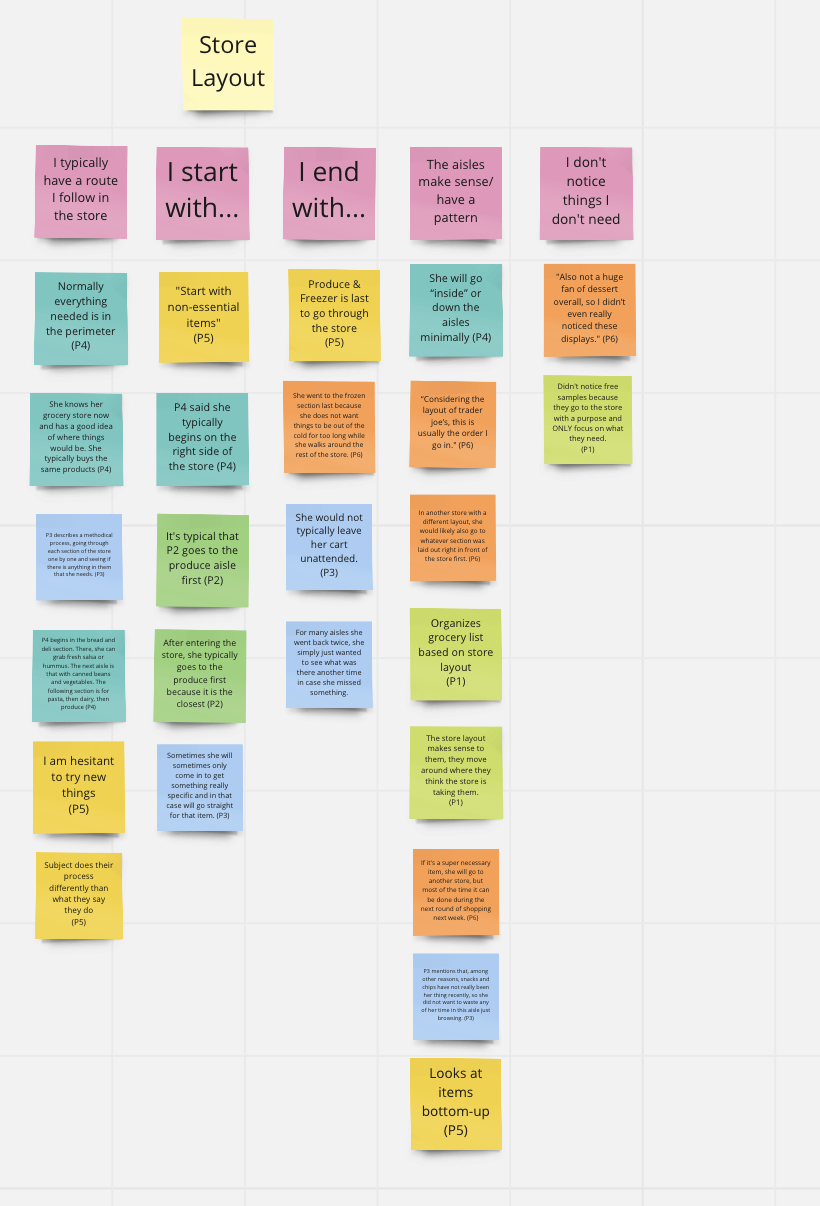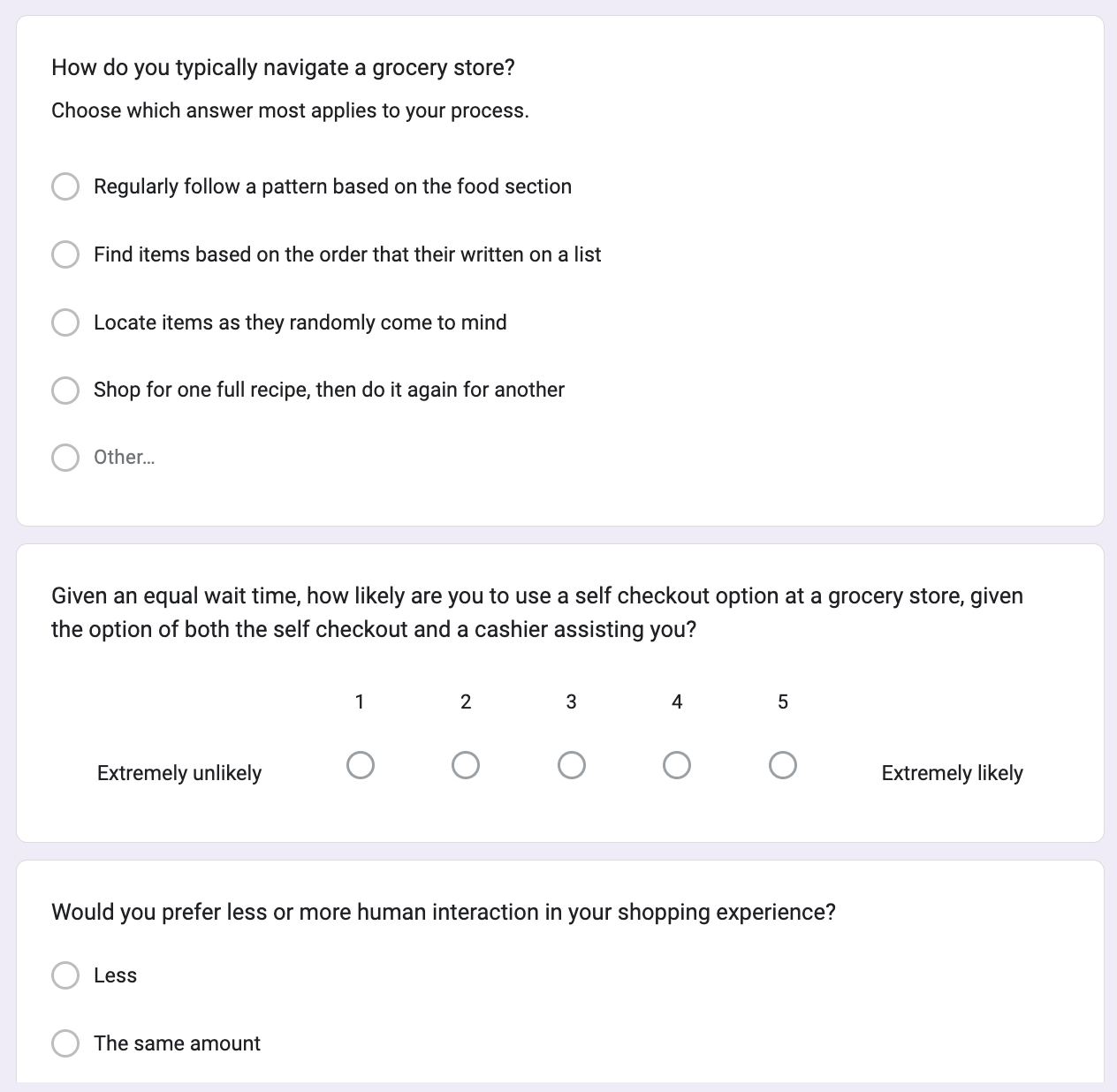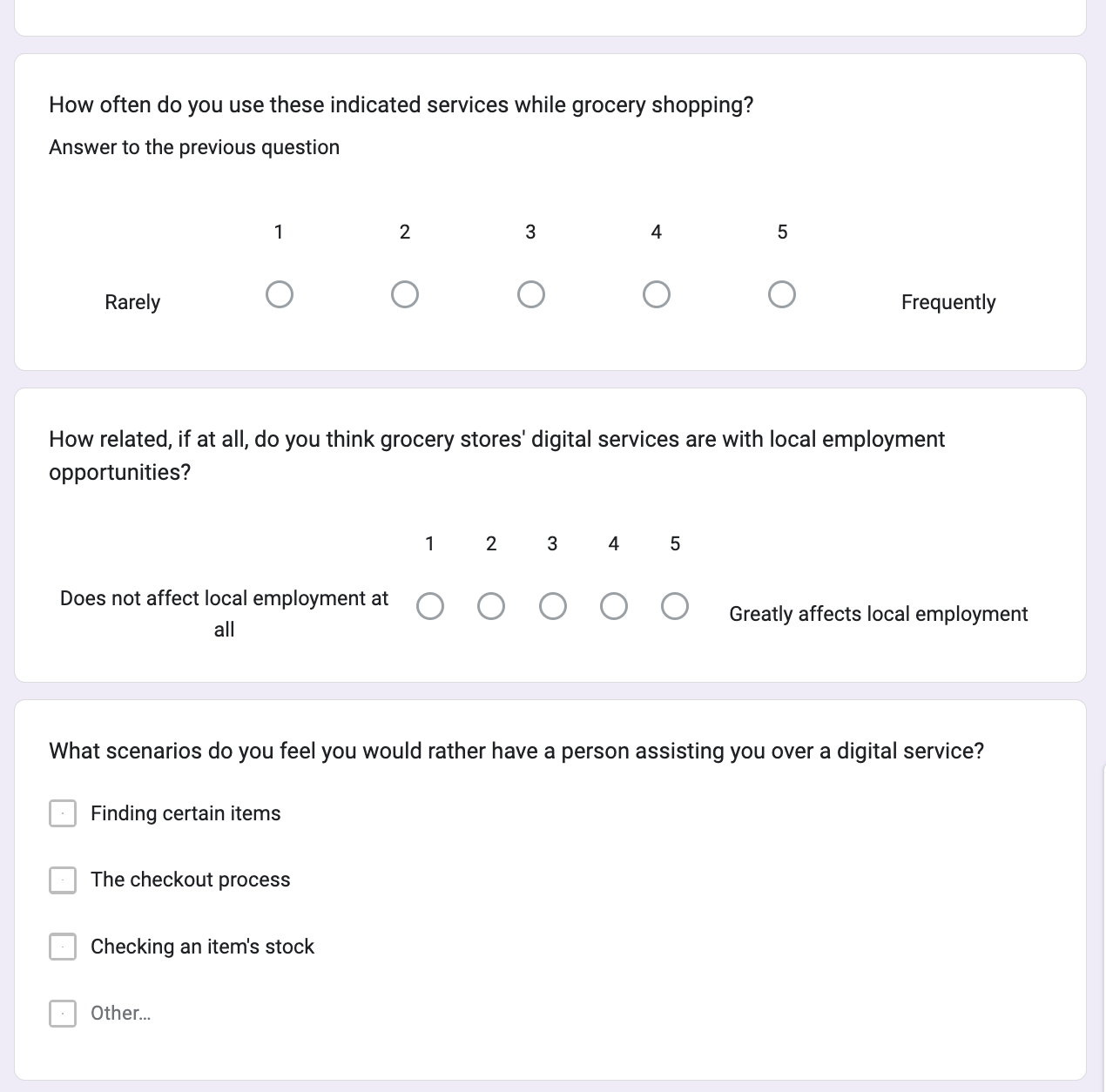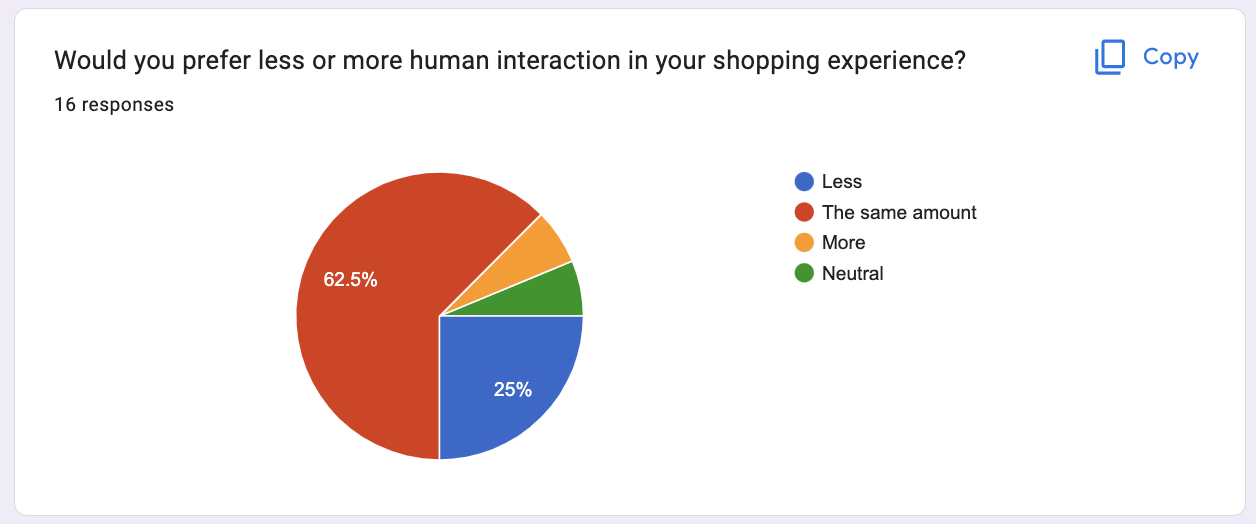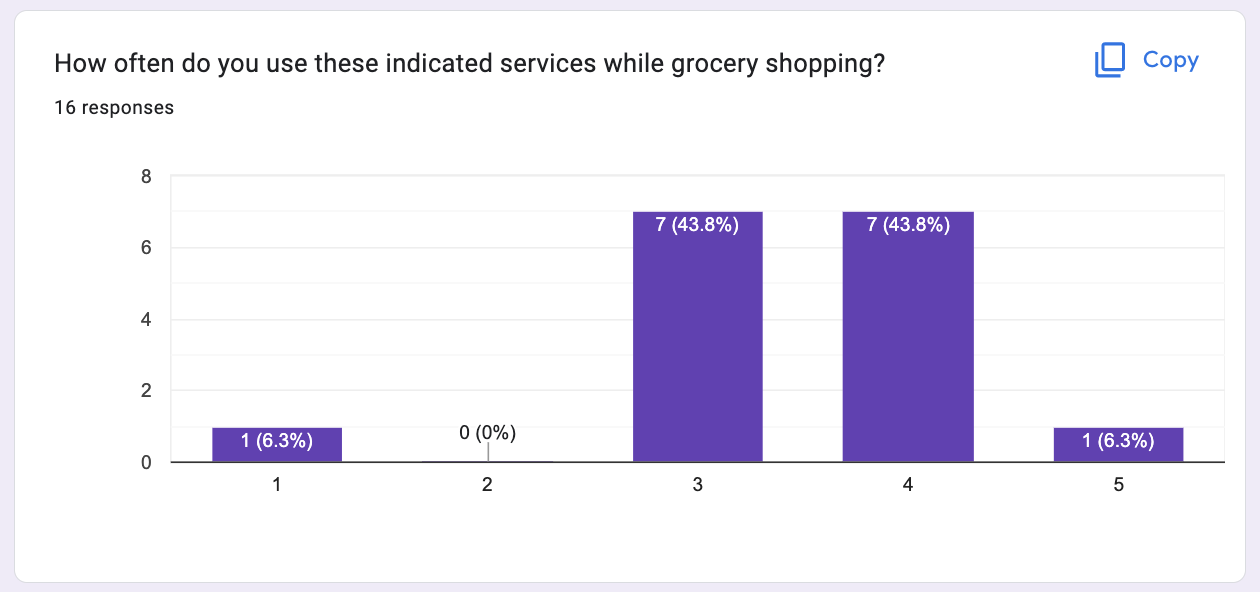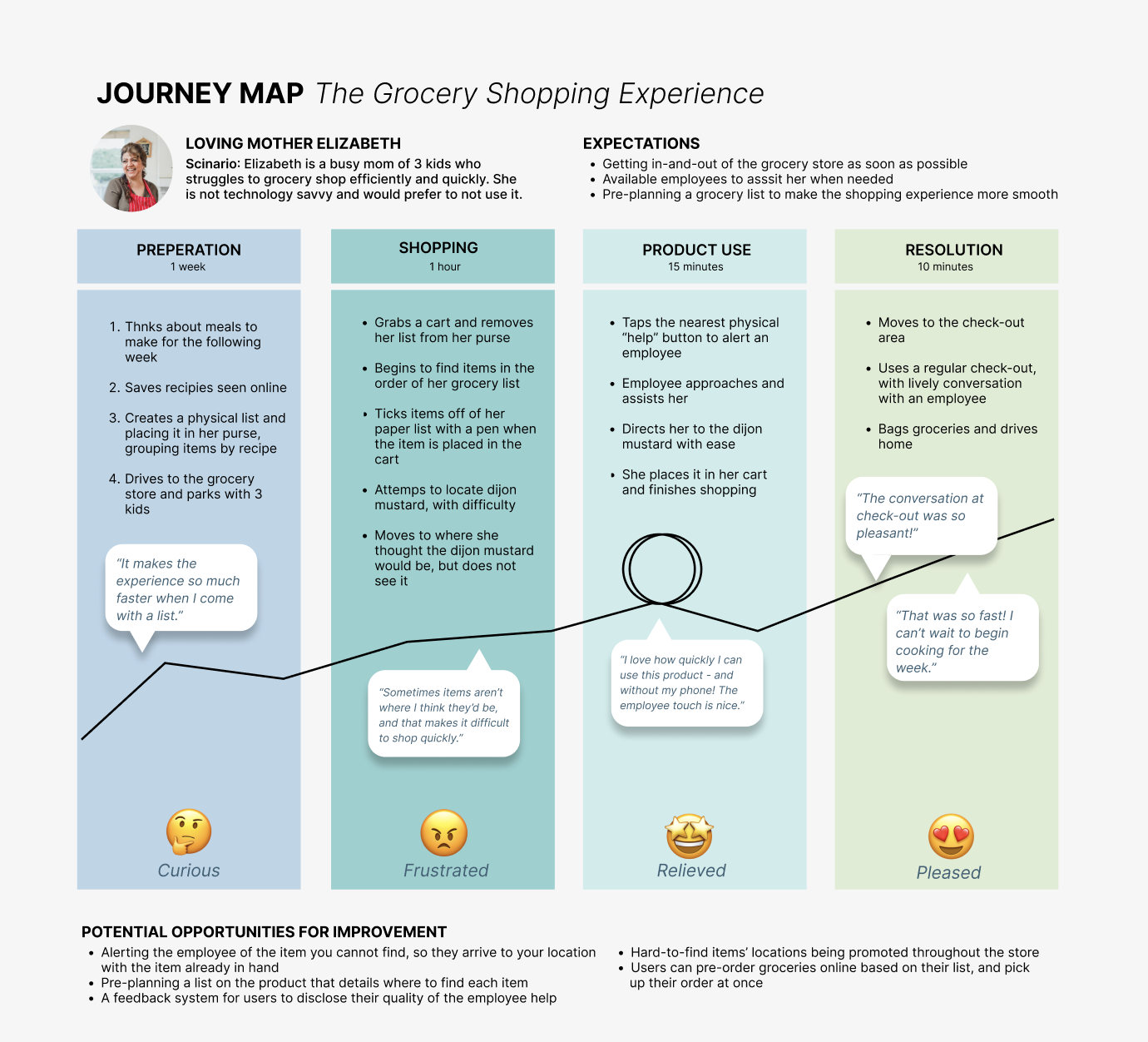Digitalized Grocery Shopping Experience.
This project took place in SI 422 - Usability Needs and Evaluation, a senior-level course at the School of Information within the University of MIchigan. I attended lectures and discussion sections to learn how to perform and improve these methods along with conducting the project.
-
Involvement.
UX Researcher (SI 422)
September 2022 - December 2022
-
Project.
Conduct user research regarding the digitally streamlined grocery store shopping experience.
-
Tools.
Excel
Figma
Problem Statement
You are hired by an Amazon competitor to investigate how grocery shopping can be digitally streamlined without reducing local employment opportunities. What are design opportunities that balance the experience of the grocery store shopper and employee?
Central Question
How might we identify the digital opportunities that enhance the shopper experience while balancing the current responsibilities of the employee?
Identify the target audience
We began by deciding the inclusion and exclusion criteria of our target users, to make sure we recruited the participants of interest for user interviews. We also created a recruitment plan to move the project along with these users in mind.
We had two types of users: shoppers and employees. So, we developed this target group for both groups that would be affected in this research.
Shoppers:
18 years or older
Responsible for their own grocery shopping for at least 3 months
Employees:
18 years or older
Worked at a grocery store for at least 3 months
Create a non-baised interview guide
We specifically planned a contextual inquiry because we believe it will give us both unbiased insight into what design aspects would make the process of grocery shopping easier for customers while still keeping the scope of responsibilities reserved for the local grocery store employees. Based on our recruitment turn-out, we only interviewed shoppers, not employees.
Structure:
Pre-shopping: semi-structured interview
Shopping: observation period with interjection of questions regarding specific actions or decisions made while shopping
Post-shopping: follow-up questions to understand their decisions
Areas of interest
How do you plan for grocery shopping?
What was the most difficult thing about this experience? How could it have been improved?
At what points, if any, would you have wanted to speak with an employee?
What aspects of the shopping/work experience can be optimized by introducing a digital component?
What aspects of the job cannot be replaced by a machine/need a human touch?
Interviewing
Our interviews were in the form of contextual inquiries, which took place at Trader Joe’s, Kroger and Target between nine individuals.
Through questions and observation, we were taking note of:
Their grocery shopping process
Pain points and frustration
Use of digital services (if any)
Opportunities for improvement
Analyzing findings
After transcribing the interviews, I analyzed findings through coding, a concise method to draw the main points from interviews.
This allowed me to draw conclusions about the interviewee’s main pain points, frustrations, and motivations. This became helpful data later for understanding what most users needed and how we could best address their needs.
Visualizing Quantitative Data
In order to visualize the data, our team used affinity diagramming. This method allowed us to see the groupings of codes and evaluate how popular that shared frustration or motivation was in their grocery shopping process.
Survey Design
Survey Objective: Perform an unbiased study to understand how grocery shoppers feel towards digitally streamlined experiences, and how those services may affect local employment opportunities.
Questions: We used a mix of open-ended, ranking on a scale, multiple choice, and multi-select options. We wanted to ensure a variety of our question types to capture the best results. We also were sure to structure our questions in a funnel format, where they begin more general at first, and gradually become more specific to our research question.
Specific Goals:
Get a ranking of places and tasks in the store where users feel overwhelmed
Get a list of jobs currently done by people users think could be done more effectively by a machine
Get a list of jobs currently done by people users think are only able to be done well by people
Get a ranking of how users feel grocery stores' digital experiences would (not) affect local employment opportunities
Get a distribution of people that prefer using digital services vs people who don't like digital services in grocery stores"
Screener Questions
-
Are you 18 years old or older?
Do you do your own grocery shopping for yourself or your household?
Have you been responsible for grocery shopping for more than 3 months?
-
Only all “yes” answer responses will be included in the rest of the survey. This ensures the participants are relatively experienced with grocery shopping and have matured opinions about its frustrations or potential improvements.
Overall Experience
-
Do you typically grocery shop at least once a month?
On a scale of 1 - 5 how would you describe your mood while grocery shopping?
How many people are you responsible for shopping for?
How do you typically navigate a grocery store?
How often do you feel you need assistance or help in the store in each shopping trip?
What do you do when you cannot find a necessary item?
-
These questions outline how users generally feel while grocery shopping and their typical processes. Based on this answer, we'll later learn what helps their process be less stressful, if that's conversations with people or digital services. These introductory questions regarding general process will also allow us to see trends, if any, to those favorable of digital services.
Digital Tools and Opportunities
-
Given an equal wait time, how likely are you to use a self checkout option at a grocery store, given the option of both the self checkout and a cashier assisting you?
The following list gives specific examples of situations at a checkout station. Please indicate which checkout process you’d rather prefer between self-checkout or regular? [Large items, coupon, less than 15 items, etc]
Indicate which of the digital services you've used in a grocery store at least one time. [Store mobile apps, self-checkout, price-checking kiosk, other]
How often do you use these indicated services while grocery shopping?
How related, if at all, do you think grocery stores' digital services are with local employment opportunities?
What scenarios do you feel you would rather have a person assisting you over a digital service?
Which do you trust more when finding an item?
What do you believe could be enhanced in your local grocery store with the addition of a digital service?
When you think about your favorite grocery store, what makes it unique from others?
-
These questions delve into users’ experiences with digital services, and under which circumstances they use them. This allows us to review digital services on a situational basis and be specific in our findings and report.
Survey Findings
People feel relatively satisfied with the amount of employee interaction they have in their current shopping experience
2. People are more likely to use digital services, especially self-checkout stations, if they think it’ll save them time
3. Self-checkouts are the most likely digital service of use, with significantly less users reporting use of store apps or item-locator products. These digital services are moderately used while shopping
4. Most users prefer employee assistance over a digital service when lost or looking for an item, and have more trust for a real person than a digital product
Creating deliverables
These findings, paired with our interviews and prior research, allowed us to visualize our target users through personas, a storyboard and a journey map.
The personas illustrate traits, motivations, pain points, goals and frustrations found through both the contextual inquiry interviews and the survey.
The storyboard demonstrates the as-is situation for our persona, Kate Smith, the student tech-lover who uses apps while shopping. It captures her pain points in the current process.
The journey map describes the to-be situation for our other persona, Elizabeth Rosen, the busy stay-at-home mom. The proposed product is based on our findings that many users prefer employee help when looking for products.
Next Steps
This research project ended at the deliverables phase. if I had more time, however, I would have been interested to:
Design a potential solution based on our user research
One idea includes a employee-finder product in the grocery store, for users who prefer human interaction as seen in user research
Usability test that potential solution
Iterate on that solution with real users’ feedback
This project, overall, was very valuable research experience. I was able to practice many skills, including:
Researching with an open mind - not with bias of a desired outcome
Listening intently to users actions, not just words, during contextual inquiries




